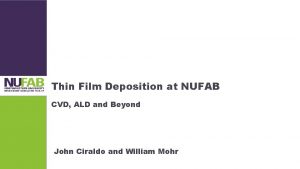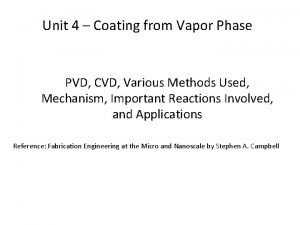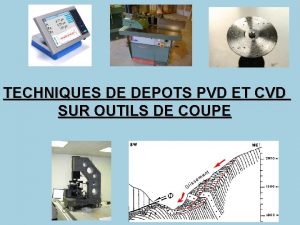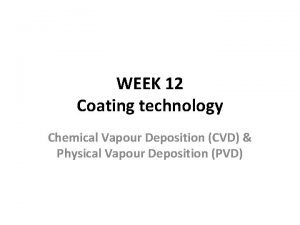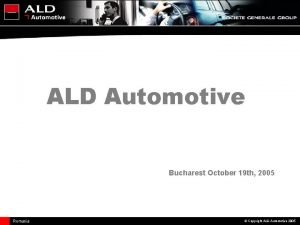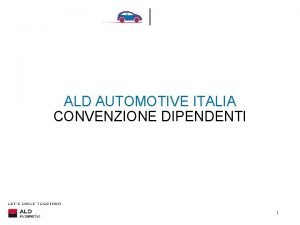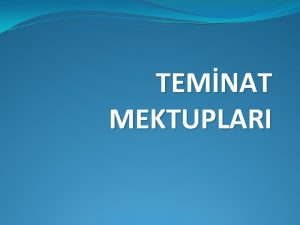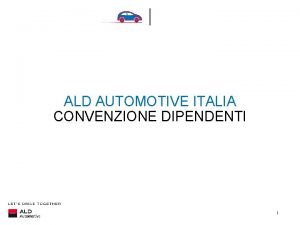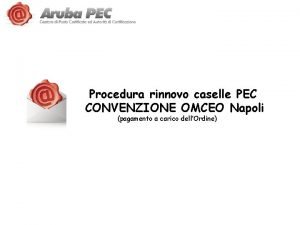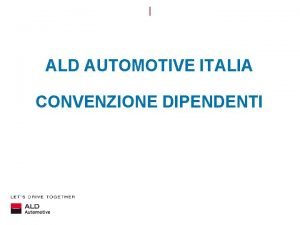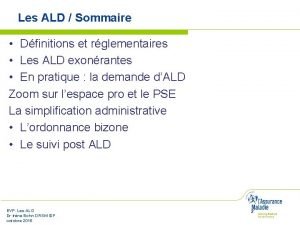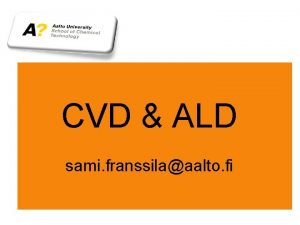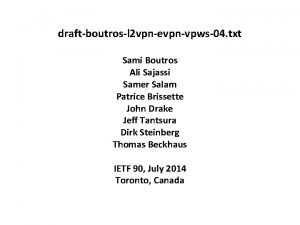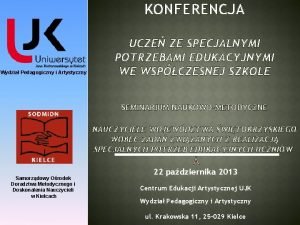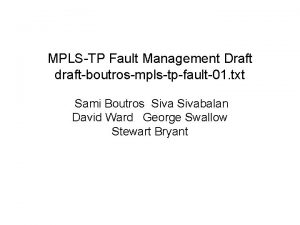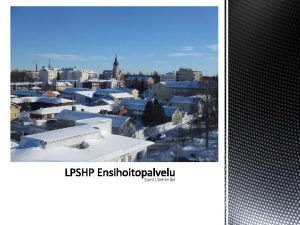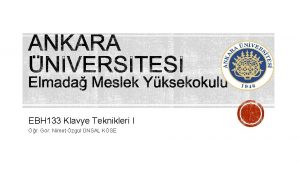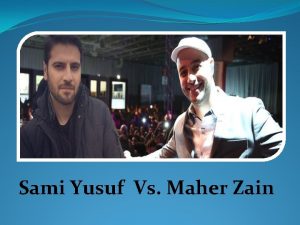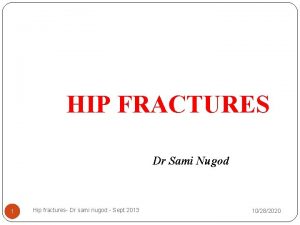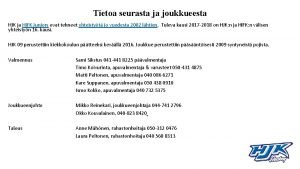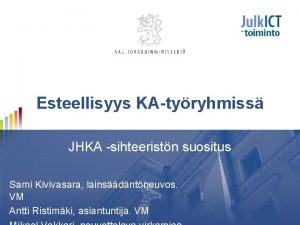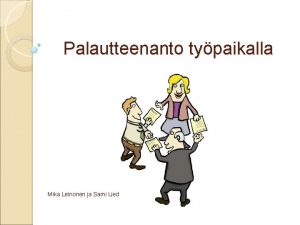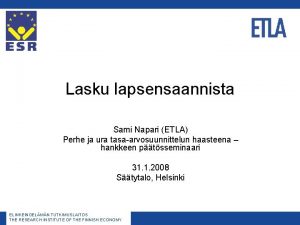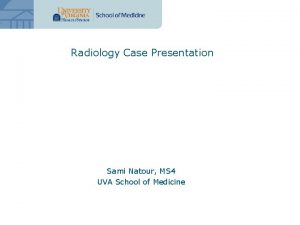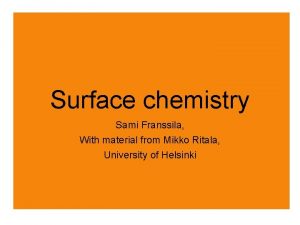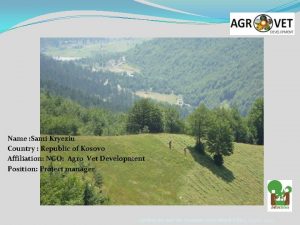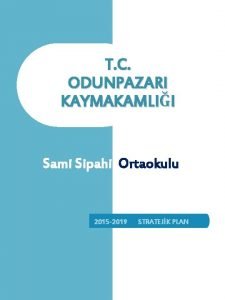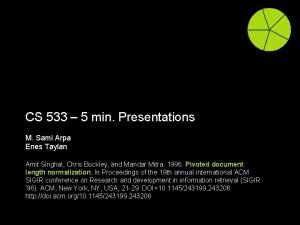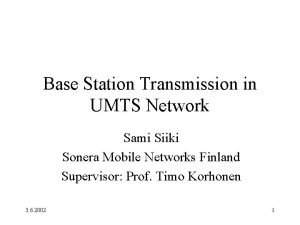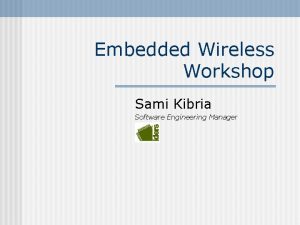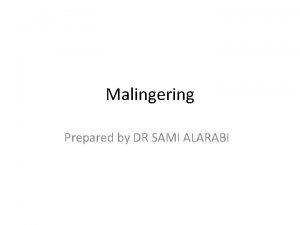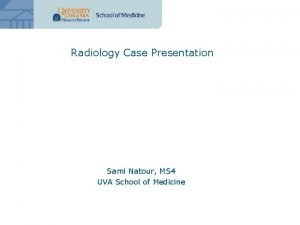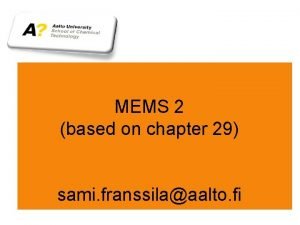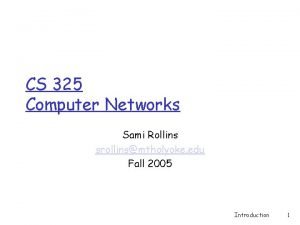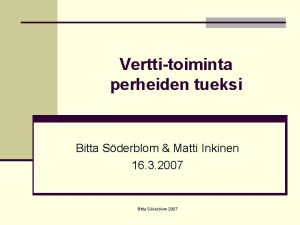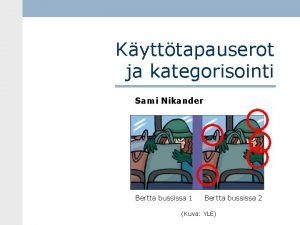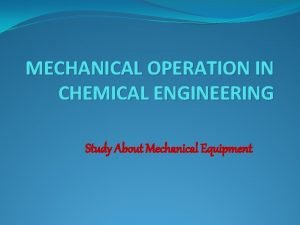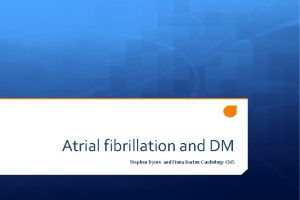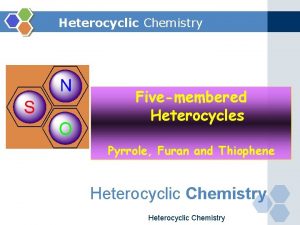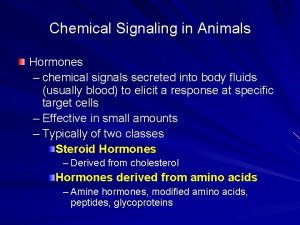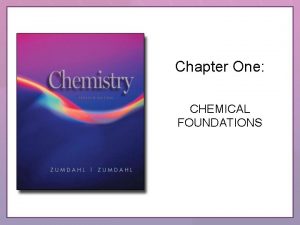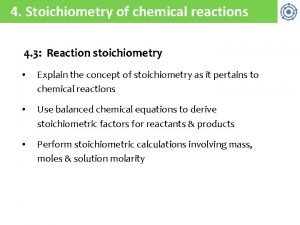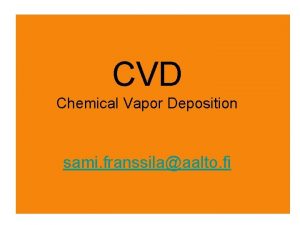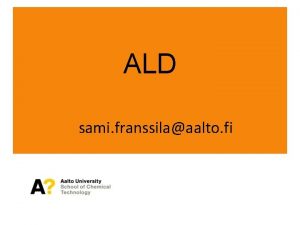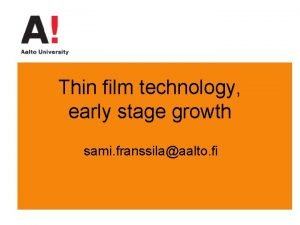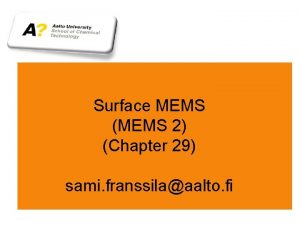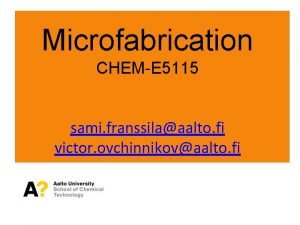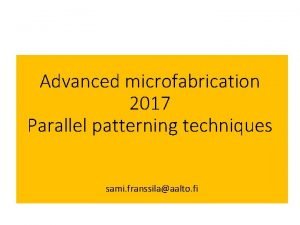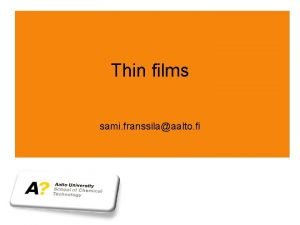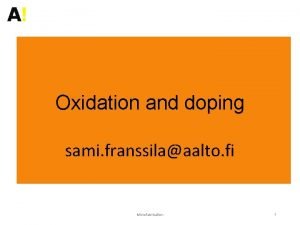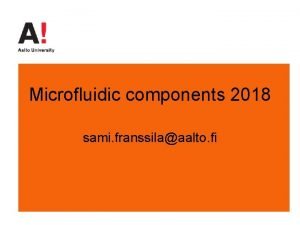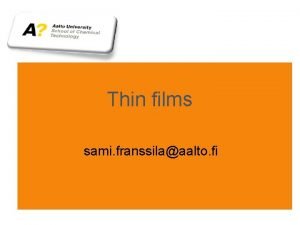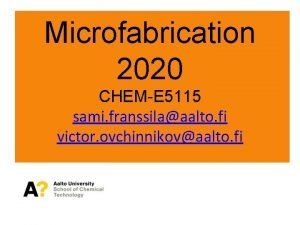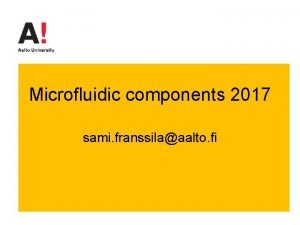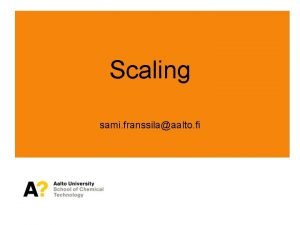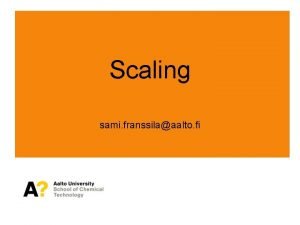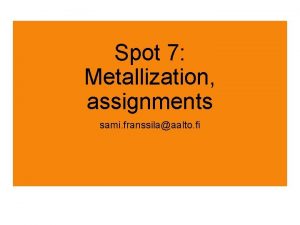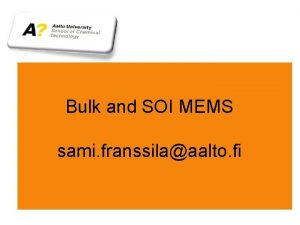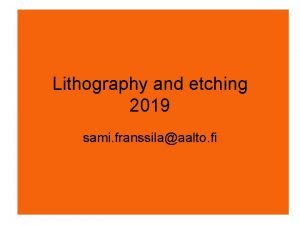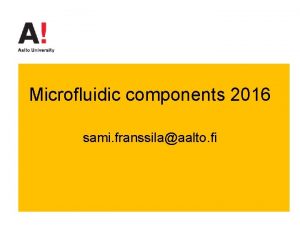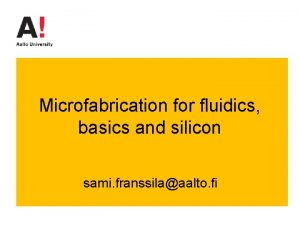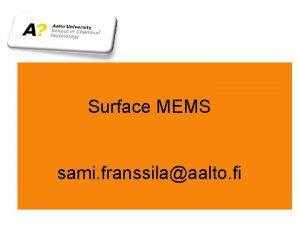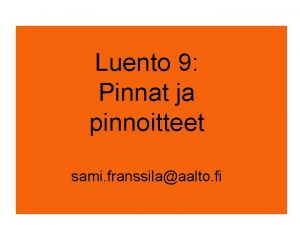CVD ALD sami franssilaaalto fi CVD ALD Chemical































































- Slides: 63

CVD & ALD sami. franssila@aalto. fi

CVD & ALD Chemical Vapor Deposition, CVD Atomic Layer Deposition, ALD Both chemical reactions and fluid dynamics must be considered.

Common CVD reactions

Thermal CVD reactions Gaseous precursor + surface reaction solid film + gaseous byproducts

Thermodynamics of CVD ΔG < 0 for reaction to take place Pierson: Handbook of CVD, p. 22

Silicon CVD from Si. H 4 Unwanted side reaction Wanted deposition reaction Smith: Thin-film deposition

Boundary layer = stagnant gas layer Pierson: Handbook of CVD, p. 36

Boundary layer thickness Re = Reynolds number density viscosity

Surface limited vs. mass transport limited reactions log rate slope = Ea 2 mass transport limited surface reaction limited slope = Ea 1 high T low T (1/T) When temperature is low, surface reaction rate is slow, and overabundance of reactants is available. Reaction is then surface reaction limited. Above a certain temperature all source gas molecules react immediately. The reaction is then in mass-transport limited regime (also known as diffusion limited and supply limited regime).

Si epitaxy: surface controlled vs. mass flow controlled

Surface limited vs. mass transport limited reactions (2) A batch reactor operating in surface reaction limited mode: -slow reaction -many wafers A mass transport limited reactor: -single wafer -high deposition rate

Thermal CVD reactor: gaseous precursors, resistive heating Franssila: Introduction to Microfabrication

Ramped furnace


Thermal CVD reactor: liquid precursors, lamp heating Changsup Ryu, Ph. D thesis, Stanford University, 1998

LRP= Limited Reaction Processing • Very fast and powerful lamp heating • Introduce gases • Flash the lamp T up reaction • Pump away the gases • Introduce new gases • Flash the lamp T up reaction. . .

PECVD: Plasma Enhanced CVD • • Plasma aids in chemical reactions Can be done at low temperatures Wide deposition parameter range High rates (1 -10 nm/s) (thermal 10% of this)

PECVD @ 300 o. C: can be deposited on many materials Oxide: Si. H 4 (g) + N 2 O (g) ==> Si. O 2 + N 2 + 2 H 2 Nitride: 3 Si. H 2 Cl 2 (g) + 4 NH 3 (g) ==> Si 3 N 4 (s) + 6 H 2 (g) + 6 HCl (g)

Si. Nx: H: thermal vs. plasma Thermal CVD at 900 o. C PECVD at 300 o. C Smith: J. Electrochem. Soc. 137 (1990), p. 614

Nitride thermal vs. PECVD (1)

Nitride thermal vs. PECVD (2)

Grain size & roughness Vallat-Sauvain

Hydrogen in PECVD films 3 Si. H 2 Cl 2 (g) + 4 NH 3 (g) ==> Si 3 N 4 (s) + 6 H 2 (g) + 6 HCl (g) 30 at% hydrogen is usual; 3 -5% is as small as it gets

CVD films lose thickness upon anneal (H 2 escapes) Polysilicon

Film quality: etch rate Low pressure equals more bombardment, and thus denser film, and compressive stress With Si. O 2, BHF etch rate is a film quality measure (should be no more than 2 X thermal oxide reference Hey et al: Solid State Technology April 1990, p. 139

Stress affects by: pressure frequency temperature

ALD: Atomic Layer Deposition Precursors introduced in pulses, with purging in-between

Materials deposited by ALD Important missing materials: • silicon nitride

ALD applications 1 nm thick catalysts (Pt, Pd) 2 nm thick Ti. N barrier layers underneath copper 6 nm thick CMOS gate oxides like Hf. O 2 10 nm thick etch masks for plasma etching (Al 2 O 3) 30 nm thick antireflection coatings in solar cells (Al 2 O 3) 200 nm thick barrier layers in flat panel displays (Al 2 O 3)

ALD applications

ALD process based on: conformal film

Surface saturation Irreversible saturation ALD reactions: Surface saturates with a monolayer of precursor, strong chemisorption (=chemical bonds formed) Reversible saturation: Physisorption only (weak bonds like van der Waals): once precursor flux is stopped, surface specie will desorb. Irreversible nonsaturating. CVD regime: more reactants in, more film is deposited (continuosly)

ALD window

Pulse-by-pulse mass monitoring

Growth rate

Layer thickness control

Layer thickness (2)

Layer thickness: nanolaminates Al 2 O 3 and Ta 2 O 5 Adriana Szeghalmi, Stephan Senz, Mario Bretschneider, Ulrich Gösele, and Mato Knez, APL 2009



Impurities in ALD

ALD uniformity (=thickness across the wafer) Hf. O 2 dielectric marathon test: 2000 wafers

Uniformity (2) ALD Si. O 2 Rate 700 nm/hr Pt

ALD conformality (=step coverage in microstructures) Excellent conformality: all surfaces coated by diffusing gaseous precursors in the surface reaction limited mode. Al 2 O 3/Ti. O 2 nanolaminate Ti. N barrier

Step coverage (2) Step coverage good also in high aspect ratio grooves, BUT pulse lenghts have to to be increased (in coating porous materials, pulses last for minutes !!).

Structure: amorphous vs. polycrystalline ?

Structure (2) amorphous aluminum oxide Polycrystalline strontium titanate Vehkamäki et al. (2001)

Plasma-enhanced ALD

PEALD



Plasma ALD benefits Plasma can break down precursors at lower temperature New precursors become available because plasma can break down precursors that could not be used in thermal ALD Ions can kick of loosely bound specie from surface, densifying the film

ALD reactors: single wafer

ALD reactors: batch

Gas pulsing

Spatial ALD jes. ecsdl. org

Spatial ALD reactors www. blog. baldengineering. com/2014_

Spatial ALD since 1977 !

ALD process development

PVD CVD & ALD Atoms as source material Molecules as source materials Solid source materials Solid, liquid, gas precursors Vacuum/high vacuum Fluid dynamics important Elemental films mostly Molecular/compound films mostly, Chemical bonds broken & formed Room temperature Alloy films easily (W: N) Needs elevated temperatures (or plasma activation) Elements and compounds OK, alloys more difficult One process, many materials Each process materials specific Al, Au, Cu, Pt, … Si. O 2, Si 3 N 4, Al 2 O 3, Hf. O 2, … Si, W

ALD CVD

CVD vs. ALD difference

Summary • Thermal CVD: excellent film quality • PECVD: reasonable film quality at low T • ALD: excellent film quality at low T • Thermal CVD: high temperature needed • PECVD: very high rate possible • ALD: best for very thin films
 Pvd cvd ald
Pvd cvd ald Chemical vapour deposition process
Chemical vapour deposition process Pvd/cvd
Pvd/cvd Commvault ports
Commvault ports Pvd vs cvd
Pvd vs cvd Ald automotive romania
Ald automotive romania Ald automotive permuta
Ald automotive permuta Kontrgaranti nedir
Kontrgaranti nedir Ald 2 life
Ald 2 life Pec napoli lextel
Pec napoli lextel Ald automotive permuta
Ald automotive permuta Ald tshirt
Ald tshirt Ald hors liste
Ald hors liste Ald
Ald Sami boutros
Sami boutros Gdyby wszyscy byli tacy sami twardowski
Gdyby wszyscy byli tacy sami twardowski Fafsav
Fafsav Sami boutros
Sami boutros Sami ramek
Sami ramek Allahumma salli ala muhammad wa ala ali muhammad
Allahumma salli ala muhammad wa ala ali muhammad Ensihoitolääkäri
Ensihoitolääkäri Sami acar f klavye
Sami acar f klavye Chapter 14 from randomness to probability
Chapter 14 from randomness to probability Sami khuri
Sami khuri Sami yusuf maher zain
Sami yusuf maher zain Perkembangan nasionalisme di asia tenggara
Perkembangan nasionalisme di asia tenggara Evans jensen classification
Evans jensen classification Sami sikstus
Sami sikstus Sami kivivasara
Sami kivivasara Mika leinonen
Mika leinonen Sami napari
Sami napari Radiology case presentation
Radiology case presentation Sami franssila
Sami franssila Sami people language
Sami people language Sami kryeziu
Sami kryeziu Sami sipahi ortaokulu
Sami sipahi ortaokulu Sami khuri
Sami khuri Sami arpa
Sami arpa Sami siiki
Sami siiki Liz buys packets of coloured buttons
Liz buys packets of coloured buttons Sami kibria
Sami kibria Sami tantawi
Sami tantawi Webcam server linux
Webcam server linux Osh imaging
Osh imaging Sami vibration switch
Sami vibration switch Sami rollins
Sami rollins Matti inkinen perhe
Matti inkinen perhe Sami nikander
Sami nikander Sami zaatari
Sami zaatari Chemical reactions section 1 chemical changes
Chemical reactions section 1 chemical changes Section 2 classifying chemical reactions
Section 2 classifying chemical reactions Love formula
Love formula Chapter 7 review chemical formulas and chemical compounds
Chapter 7 review chemical formulas and chemical compounds Chapter 18 chemical reactions balancing chemical equations
Chapter 18 chemical reactions balancing chemical equations Section 2 reinforcement classifying chemical reactions
Section 2 reinforcement classifying chemical reactions Cyclone chemical engineering
Cyclone chemical engineering Non examples of chemical reactions
Non examples of chemical reactions Chemical cardioversion
Chemical cardioversion Chemistry symbols in equations
Chemistry symbols in equations School architecture change chemical
School architecture change chemical Reactions of pyrrole
Reactions of pyrrole Chemical signaling
Chemical signaling Chemical distillation apparatus
Chemical distillation apparatus Stoichiometry map for chemical reactions
Stoichiometry map for chemical reactions
